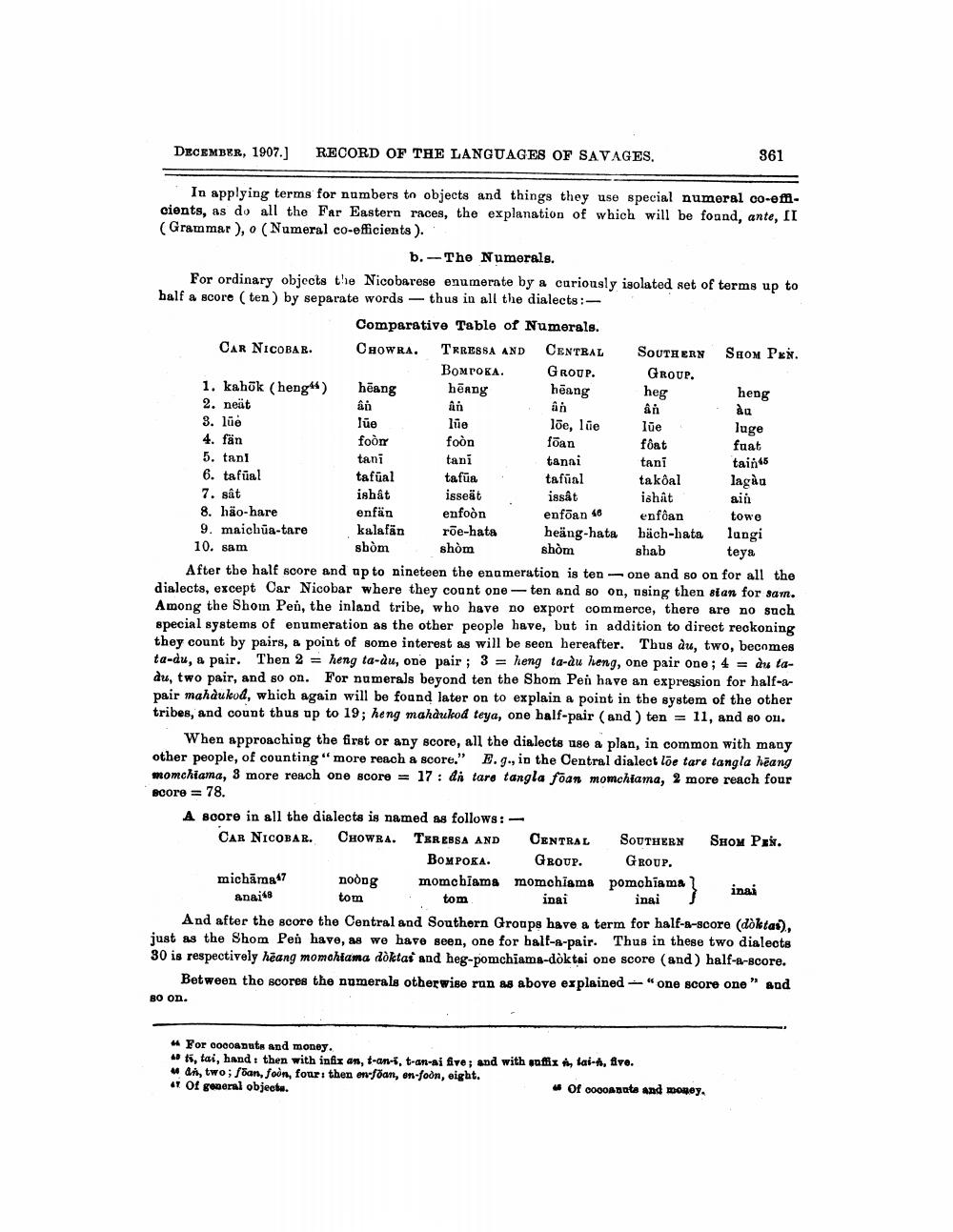________________
DECEMBER, 1907.] RECORD OF THE LANGUAGES OF SAVAGES.
In applying terms for numbers to objects and things they use special numeral co-efficients, as do all the Far Eastern races, the explanation of which will be found, ante, II (Grammar), o (Numeral co-efficients).
b. The Numerals.
For ordinary objects the Nicobarese enumerate by a curiously isolated set of terms up to half a score (ten) by separate words thus in all the dialects:
Comparative Table of Numerals.
CHOWRA.
TERESSA AND
ВОМРОКА.
heang
CAR NICOBAR.
1. kahōk (heng44)
2. neät
3. lué
4. fän
5. tani
6. tafual
7. sât
8. häo-hare
9. maichua-tare
10. sam
so on.
heang
ân
lue
foor
tani
tafual
ishât
enfän
kalafän
shòm
ân
lue
foon
michāma47 anai48
tani
tafua
isseät
enfoòn
rōe-hata
shòm
CENTRAL
GROUP.
heang
ân
lõe, lue
foan
noong
tom
tanai
tafual
issât
enföan 46 heäng-hata shòm
SOUTHERN
A score in all the dialects is named as follows:CAR NICOBAR. CHOWRA. TERESSA AND CENTRAL ВОМРОКА. GROUP. GROUP. momchiama momchiama pomchiama inai
tom
inai
SOUTHERN
GROUP. heg
ân
lue
foat
tani
takoal
ishât
enfôan häch-hata shab
After the half score and up to nineteen the enumeration is ten-one and so on for all the dialects, except Car Nicobar where they count one-ten and so on, using then sian for sam. Among the Shom Pen, the inland tribe, who have no export commerce, there are no such special systems of enumeration as the other people have, but in addition to direct reckoning they count by pairs, a point of some interest as will be seen hereafter. Thus àu, two, becomes ta-du, a pair. Then 2 = heng ta-du, one pair ; 3 = heng ta du heng, one pair one ; 4 = du t du, two pair, and so on. For numerals beyond ten the Shom Pen have an expression for half-apair mahàukod, which again will be found later on to explain a point in the system of the other tribes, and count thus up to 19; heng mahàukod teya, one half-pair (and) ten 11, and so on.
361
When approaching the first or any score, all the dialects use a plan, in common with many other people, of counting "more reach a score." E. g., in the Central dialect lõe tare tangla heang momchiama, 3 more reach one score 17: dn tare tangla foan momchiama, 2 more reach four score = 78.
For cocoanuts and money.
ti, tai, hand: then with infix an, t-an-i, t-an-ai five; and with suffix, lai-h, five.
an, two; foan, foon, four: then en-föan, en-foon, eight.
47 Of general objects.
SHOм PEN.
heng
àu
Of cocoanuts and money.
luge
fuat
tain45
lagàu
ain
towe
langi
teya
And after the score the Central and Southern Groups have a term for half-a-score (doktas), just as the Shom Pen have, as we have seen, one for half-a-pair. Thus in these two dialects 30 is respectively heang momohiama doktas and heg-pomchiama-dòktai one score (and) half-a-score. Between the scores the numerals otherwise run as above explained -« one score one
"and
SHOM PEN.
inai




